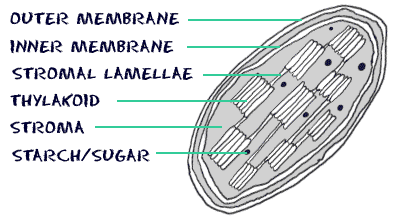Cards In This Set
| Front | Back |
|
Structure of the chloroplast Where does light reaction and calvin cycle take place?
|
 Extra membrane to allow for gradient Thylakoid--Light Reaction Stroma-- Calvin Cycle |
|
At the end of the light reaction, where is the energy derived from the photons stored?
|
Stored as NADPH and ATP
|
|
Summarize reactions occurring in the three phases of the Calvin cycle
|
Fixation: -carbon is fixed out of the atmosphere by rubisco to a 5 carbon RuBP molecules -it is broken into 2 3-Carbon atoms (3-phosphoglycerate)
Reduction:-add ATP and NADPH to create G3P which goes on to become glucose or used for regeneration Regeneration: G3P regenerated by RuBP (requires ATP) |
|
Why is RUBISCO the most important enzyme on earth?
|
Because it fixates carbon out of the air -one of least efficient enzyme
|
|
What does fixed mean?
|
Extracting Carbon Dioxide and putting it in a usable form
|
|
How does the current atmosphere differ from that inw hich potohsytehesis evlove?
How does the earth atmosphere reduce the efficiency of rubsio? |
Oxygen levels used to be much lower and CO2 levels used to be much higher
Switched-as CO2 dropped that is when photosynthesis evolved Because oxygen can fit into binding site of rubisco reduces the efficiency--uses oxygen instead of CO2 which competes at enzymes active sites which slows the rate of CO2 reduction HAD TO EVOLVE WAYS TO AVOID PHOTORESPIRATION ( fixated oxygen not carbon) |
|
In what two ways does photorespiration drain energy from the plant?
|
1. Uses energy2. Loss of Fixed carbon
|
|
Describe the interior of a typical leaf. How do gasses move from the atmosphere to the interior of the leaf?
|
Atmosphere gases go through the stomata into the air space where the mesophyll cells fix carbon out of the atmosphere
|
|
What are the advantages and disadvantages to a plant of OPENING stomata? and of CLOSING stomata
|
OPEN:-gain carbon dioxide-lose oxygen (PRO)-lose water (CON)
CLOSING-not gain carbon dioxide-don't lose oxygen (CON)-don't lose water (PRO) |
|
C4 and CAM photosynthesis are described as "CO2 pumps" How do these forms of photosynthesis differ from C3 and why should they be characterized as "pumps"?
|
Function as pumps to minimize the amount of photorespiration that occurs when stomata are closed and CO2 cannot diffuse directly from atmosphere
-process is different and how CO2 is moved through cell different and when its allowed to move into cell |
|
In C4 and CAM plants rubisco always operates under conditions of elevated CO2
|
In C4 and CAM plants rubisco always operates under conditions of elevated CO2
|
|
Predict the relative success of C3, C4 and CAM plant in a..1. cool2. wet environment 3. hot dry environment
|
C31. good 2. good3. bad
C41. ok (less good-requires energy)2. ok (less good-requires energy)3. good CAM1. ok (less good-requires energy)2. ok (less good-requires energy)3. good |
|
What happens to the sugar that is produced by photosynthesis?
|
1. Respiration2. used in cell walls/cellulose3. storage4. structure
|
|
C4
|
-CO2 air and O2 come in
-fixed in mesophyll by pep carboxylase-through plasmodesmata into bundle sheath-go through mitochondria where C4 is converted to C3-C3 regenerated-CO2 goes to chloroplasts where it is converted to starch FIXES MORE CARBON |
|
CAM
|
-stomata open at night and closed during the day -fixes carbon at night-PEP Carboxylase -C4 goes into vacuole where it is stored until day time-C4 is converted to C3 -CO2 goes to chloroplasts where it is converted to starch
prevents water loss by stomata being open at night |



